|
Daisy News | Daisy Hall of Fam
Daisy
News | Daisy Hall of Fame |
Daisy History |
About the Museum
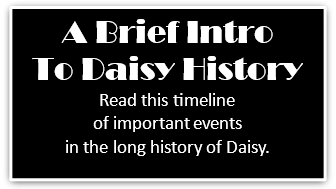 The
1880's - "It's a Daisy!" The
1880's - "It's a Daisy!"
The year
was 1886. France had just given the bright copper
Statue of Liberty to the United States. Coca-Cola
had just been invented and was only available as a
syrup mixed with soda water. The Plymouth Iron
Windmill Company in Plymouth, Michigan, just outside
of Detroit, had for four years been making iron
windmills for farmers. However a premium item, given
free to farmers who purchased these windmills, was
about to change that company's destiny.
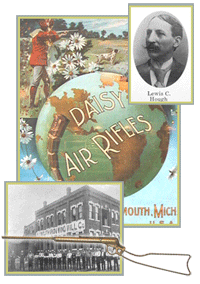 Windmill sales did not take off as expected and the
company came close in 1888 to liquidating. The vote
failed by one vote - that of General Manager Lewis
Cass Hough. While the "Chicago" air rifle--made
almost entirely of wood - had been made since 1885
by the Markham Air Rifle Company of Plymouth,
Hamilton was the first to develop a metal air rifle.
After firing the gun (first at a basket of red-ink
covered paper and then an old shingle), Hough
exclaimed in the slang of the time, "Boy, that's a
Daisy!" and later convinced the Board of Directors
to use the metal air rifle as a premium item. Windmill sales did not take off as expected and the
company came close in 1888 to liquidating. The vote
failed by one vote - that of General Manager Lewis
Cass Hough. While the "Chicago" air rifle--made
almost entirely of wood - had been made since 1885
by the Markham Air Rifle Company of Plymouth,
Hamilton was the first to develop a metal air rifle.
After firing the gun (first at a basket of red-ink
covered paper and then an old shingle), Hough
exclaimed in the slang of the time, "Boy, that's a
Daisy!" and later convinced the Board of Directors
to use the metal air rifle as a premium item.
The popularity of the premium item was huge. Farmers
were more interested in the "Daisy" than the
windmill-- so much so that the focus of the company
shifted from windmills to airguns. By 1890, the
twenty-five employees of Plymouth Iron Windmill
Company were producing 50,000 guns, most of which
were distributed within a radius of one hundred
miles of the factory.
The
1890's - Out of the Windmill Business
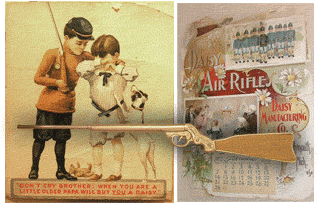 "I
am not a good shot, but I shoot often." "I
am not a good shot, but I shoot often."
- Theodore Roosevelt
"With a 1000-shot Daisy Repeater,
you can shoot both straight and often."
- Daisy MFG. CO.
1891 - Charles Bennett is hired to serve as the
Company's first salesman at a salary of $85/month
plus expenses. Two days after being hired, Bennett
makes a trip to Chicago and sell 10,000 guns to
Hibbard, Spencer, Bartlett & Company. The order is
filled in 6 months.
1893 - Edward C. Hough joins the company to keep the
books part time while continuing to run his father's
grain elevator business.
1895 - The Plymouth Iron Windmill Company gets out
of the windmill business for good and changes it's
name to Daisy Manufacturing Company.
The
1900's - Establishing a Global Market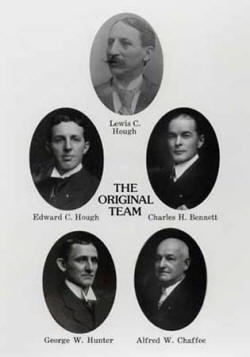
By the end of
the 19th Century, Daisy had established itself as
the dominate force in the burgeoning air gun
industry, having seen the appearance and demise of
some 30 competitors during its first decade. The
company continues to hold that market-dominant
position today.
Daisy suffered a major loss with the death of Lewis
Cass Hough on January 11, 1902 at the age of 56.
L.C. Hough was one of the founders of the Plymouth
Iron Windmill Company and as General Manager had
fought hard to keep the struggling company operating
during its early years. With his passing, C. H.
“Uncle Charlie” Bennett was named General Manager
and E. C. Hough, son of L.C., was named
Secretary/Treasurer. For the next 60 years this
remarkable team directed the affairs of Daisy.
In January of 1903 Daisy introduced its first lever
action repeater, the No. 3 which was a nickel
plated, 1,000-shot rifle, that was to become the
hallmark of Daisy styling and set the tone for
forward thinking innovation that has served Daisy so
well though the years. The new little rifle so
captured the attention and interest of wholesalers
and consumers that it sold over 36,000 units the
first year.
With the advent of the 20th Century, Daisy’s export
business was approaching 25% of its total annual
sales without any real effort on the part of the
company. At that point Charlie Bennett determined to
pursue the international market and rather than hire
someone for that purpose decided to pack up and make
the world tour himself. From April to September 1907
Mr. Bennett traveled the world establishing Daisy’s
export market. His trip, especially the China leg,
is one of the many interesting stories related at
the Daisy Airgun Museum.
The
1910's - The Lefever Years Begin
In late December 1911 a letter from a Charles F. Lefever of St. Louis found its way to the desk of E.C. Hough. In it Mr. Lefever said he had designed a pump gun. He laid out his credentials and said if Daisy was interested someone could “…come to St. Louis to see me, and I will show you the gun.” With the flurry of end of year business a perfunctory response was sent saying that if Daisy were interested “…he would be contacted in the future.” Back came a letter saying if Daisy wasn’t interested others would be. Some years later Mr. Hough said such a letter would have turned him off but because the concept intrigued him he set out in early February to visit St. Louis and meet Mr. Lefever. Mr. Hough quickly realized that the gun design and the man were unique and invited him to Plymouth to which he agreed saying ”… for a few months to get you started.”
A month later Lefever arrived in Plymouth and
remained a part of Daisy until his retirement in
February 1953. During the ensuing years Lefever
designed and engineered such Daisy classics as the
Model 25. That remarkable pump gun, which was first
produced in 1914, continued in production for the
next 64 years until it was dropped from the line in
1979. At the time it was discontinued more than
8,000,000 of the guns had been produced and sold.
Within two years of his arrival he had also designed
the first water pistol and with the outbreak of
World War I in August 1914, the Model 40 Defender
which was an instant and overwhelming commercial
success.
A cantankerous soul, Lefever quit nearly once a year
during the 41 years he “chose to work for Daisy.”
The first handmade prototype of Lefevre’s Model 25
pump gun is on display at the Daisy Airgun Museum.
The
1920's - Daisy and the BB Business
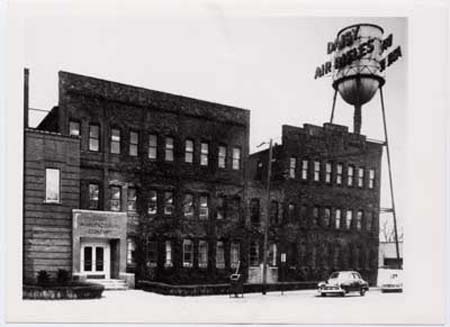 In
the early days of air rifles, shot tubes were sized
to utilize lead drop shot that was approximately
.180 inches in diameter; a size referred to as “BB”,
hence the name “BB gun”. In
the early days of air rifles, shot tubes were sized
to utilize lead drop shot that was approximately
.180 inches in diameter; a size referred to as “BB”,
hence the name “BB gun”.
Shortly after the turn of the century, seeing the
potential in the air gun ammo business, Daisy
prevailed upon the makers of lead shot to create a
special size ball with an average diameter of .175
inches and call it “”Air Rifle Shot”. However, the
name “BB” stuck and is still in common use today.
In the mid 1920’s Daisy began to experience an
unusually high rate of returns the source of which
was ultimately traced to the American Ball Company
in Minneapolis, Minnesota, a manufacturer of steel
ball bearings. Apparently, enterprising young lads
in the area were salvaging bearings from the scrap
out back of the plant to shoot in their guns. While
some scrap worked well in the guns, some was
oversize and either jammed or split the shot tube.
When this was called to the attention of American
Ball Company, some quick market research on their
part revealed that there was a bigger market for air
rifle shot than for their particular brand of
bearings. Armed with this information they began
manufacturing and selling steel balls in a size
approximating air rifle shot under the brand name
“Bulls Eye”.
Because steel shot was less expensive to manufacture
and performed better due to its lighter weight,
sales skyrocketed. Quick to realize their return
problems were only going to compound Daisy
redesigned its shot tubes to accommodate the “Bulls
Eye” ammo and negotiated an agreement to become the
exclusive sales agent for American Ball. The
arrangement continued smoothly until Daisy, acquired
the assets of American Ball Company in early 1939.
The
1930's - The Busy 30’s!
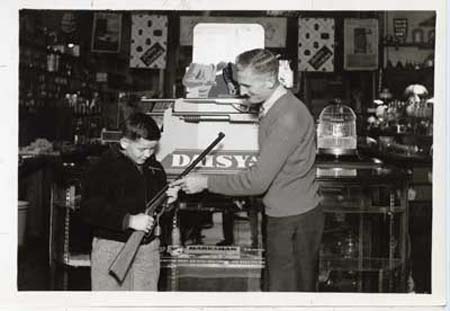 In
company with most other businesses, Daisy entered
the 1930’s suffering losses in sales and profits
because of the state of the national economy. As the
depression wore on Daisy learned that with fresh new
advertising and sales promotion it did not have to
“…take its lumps” with the rest of the world. It set
up a pattern of promotional activity that is still
the hallmark of the Daisy operation today. In
company with most other businesses, Daisy entered
the 1930’s suffering losses in sales and profits
because of the state of the national economy. As the
depression wore on Daisy learned that with fresh new
advertising and sales promotion it did not have to
“…take its lumps” with the rest of the world. It set
up a pattern of promotional activity that is still
the hallmark of the Daisy operation today.
One devise used to generate business during the
depression was an offer for youngsters to trade in
their old BB guns for new models. Much that came in
was pure junk but a surprising number were in
remarkably good shape and now make up much of what
is on display in the Daisy Airgun Museum.
The 1930’s also saw Daisy advertising and promotions
take on new directions that were to keep it
operating at full capacity throughout the tough
depression years. The first of those was a tie in
with a young cowboy circus star named Buzz Barton.
An instant sales success, another quickly followed
with the most popular cowboy movie character of the
time, Buck Jones.
The most successful, however, was taken from the
pages of the newspaper comic strip Buck Rogers and
the 25th Century. Introduced in 1933, the Buck
Rogers Rocket Pistol was an instant success and was
quickly followed the next year by the Buck Rogers
Disintegrator Pistol and finally in 1935 by the
Liquid Helium Pistol. All of which set sales records
year after year.
Much of this ground breaking advertising and
promotional material from the 1930’s is on display
at the Daisy Airgun Museum.
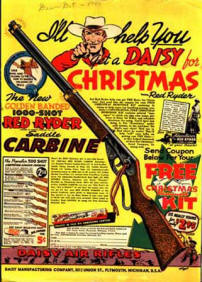 The
1940's - "Howdy Podner. My Name’s Red Ryder!" The
1940's - "Howdy Podner. My Name’s Red Ryder!"
With the ground work firmly laid by the innovative
promotions of the 1930’s, Daisy was ready to launch
into its most successful promotion ever; the Daisy
Red Ryder!
Based on the popular comic strip western hero, the
new gun was introduced in the spring of 1940 and
produced until mid 1942 when Daisy’s production was
converted to the war effort. Following the war, the
air gun was reintroduced in November 1945. By 1949
it had become so popular that more than one million
units were sold in a single year; a sales figure
unheard of at the time! In fact, the Red Ryder had
become so popular that on more than one occasion
mail was received at the Daisy offices in Plymouth,
Michigan addressed simply to the “Red Ryder
Company”.
The Red Ryder was and sill is the best-known BB gun
ever built and a special display of Red Ryder BB
guns at the Daisy Airgun Museum follows the
progression of the Red Ryder over the years.
It was also in the late 40’s that Daisy introduced
the famous penny pack of BBs wound in a long roll of
individual cellophane segments allowing a youngster
to tear off as many packs as his finances would
support.
The
War Years
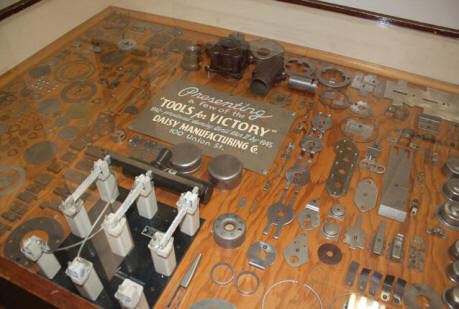 During
the years of World War II, companies such as Daisy
were prohibited from using steel and other strategic
materials for production of products such as BB guns
which were non-essential to the American war effort.
Instead, production was focused on items ordered
under War Department contracts and sub-contracts,
such as the parts you see displayed in the flat
case. Gaskets were produced for AC Spark Plug
Division, switches for Square D Manufacturing, ball
races for Palmer-Bee, washers for Ligon Brothers,
and dies for Bendix Aviation, Nippert Electric and
Pilgrim Drawn Steel. Of the company’s total sales
from 1942 to 1945, almost 24% were from products for
the war and the balance were from non-steel toy
products. During
the years of World War II, companies such as Daisy
were prohibited from using steel and other strategic
materials for production of products such as BB guns
which were non-essential to the American war effort.
Instead, production was focused on items ordered
under War Department contracts and sub-contracts,
such as the parts you see displayed in the flat
case. Gaskets were produced for AC Spark Plug
Division, switches for Square D Manufacturing, ball
races for Palmer-Bee, washers for Ligon Brothers,
and dies for Bendix Aviation, Nippert Electric and
Pilgrim Drawn Steel. Of the company’s total sales
from 1942 to 1945, almost 24% were from products for
the war and the balance were from non-steel toy
products.
Colonel Cass Hough (then vice president and later
president of Daisy) went on extended active duty in
the 8th Air Force, just six months prior to the
attack on Pearl Harbor. A decorated test pilot and
fighter pilot, he didn’t return from overseas until
October, 1945, having won many an air battle from
the English Channel to New Guinea. Most notably, he
had the distinction of having tested the limits of
the Lightning P-38 in an experimental, yet
successful, 43,000-foot vertical dive during which
the plane broke the sound barrier.
According to his Air Force citation which was
accompanied by the Distinguished Flying Cross,
“Colonel Hough achieved…the longest terminal
velocity dive in history. He knowingly and
deliberately entered unknown regions of the air. The
courage, skill and devotion to duty displayed by
this officer reflect the highest credit upon himself
and the Armed Forces of the United States.”
The banner and Roll of Honor you see here were
proudly displayed in the Plymouth, Michigan plant
where they saluted those in active military service
during World War II.
Throughout history and numerous wars and conflicts,
Daisy remains grateful to and proud of our employees
who have so selflessly served our country,
distinguished themselves and even made the ultimate
sacrifice for freedom.
The
1950's - The Team Passes and Daisy Goes South
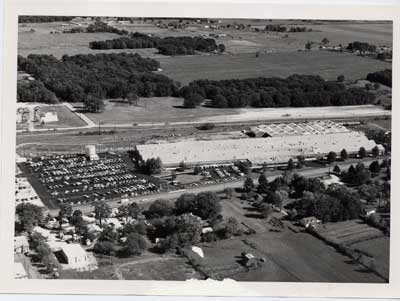 The
1950’s saw the loss of the two individuals whom,
more than any others, guided Daisy to its position
of dominance in the American airgun industry. On
September 17, 1956 “Uncle Charlie” Bennett passed
away at the age of 94. Up until a few weeks before
his death he never failed to put in a daily
appearance at the Daisy office. Less than 2 years
later on January 24, 1959 E. C. Hough died at the
age of 86. With their passing, Daisy lost the team
that had guided it through three major world
conflicts, three devastating economic downturns, and
past countless competitors both large and small to
emerge as the company whose name was synonymous with
the BB gun. The
1950’s saw the loss of the two individuals whom,
more than any others, guided Daisy to its position
of dominance in the American airgun industry. On
September 17, 1956 “Uncle Charlie” Bennett passed
away at the age of 94. Up until a few weeks before
his death he never failed to put in a daily
appearance at the Daisy office. Less than 2 years
later on January 24, 1959 E. C. Hough died at the
age of 86. With their passing, Daisy lost the team
that had guided it through three major world
conflicts, three devastating economic downturns, and
past countless competitors both large and small to
emerge as the company whose name was synonymous with
the BB gun.
By the late 50’s the antiquated Daisy factory was
becoming increasingly less efficient as modern
manufacturing processes progressed. This factor
coupled with spiraling taxes and a tightening labor
market caused Daisy to begin a search for a new
location more central to its distribution. The
search, quietly carried out over a period of months,
finally centered on a small northwest Arkansas
community. On April 30, 1958 Daisy closed its doors
for the last time in Plymouth, Michigan and the
first train cars full of machinery started south to
Rogers, Arkansas. July 1, 1958 was the target date
to begin production in its new location but the
first gun came off the line on June 26th four days
ahead of schedule.
Daisy’s relocation to Rogers, Arkansas in 1958
represented the first major investment by industry
in this highly rural region. It preceded the area’s
ultimate development into the hub of Arkansas’
economy. Today the market area (now referred to as
Northwest Arkansas) is home to numerous corporate
offices including the world’s largest retailer and
poultry producer.
The
1960's - Spittin’ Images and Shooting Education
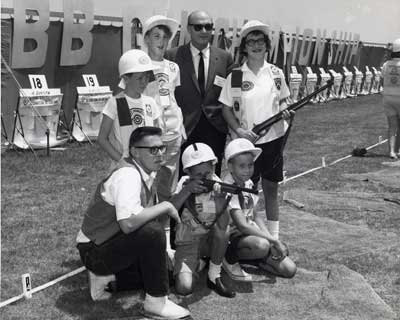 Early
in 1963 Daisy partnered with the U.S. Jaycees to
launch what was ultimately to become the nation’s
largest and most far reaching youth Shooting
Education Program. To date the grass roots program
has taught more than 10 million young boys and girls
the fundamentals of safe gun handling and
marksmanship. It concludes each year with the Daisy
National BB Gun Championship Match (The Daisy
Nationals.) The first of these was held in July,
1966 in Vandalia, Ohio and the national match now
continues annually in Daisy's hometown of Rogers,
Arkansas. Early
in 1963 Daisy partnered with the U.S. Jaycees to
launch what was ultimately to become the nation’s
largest and most far reaching youth Shooting
Education Program. To date the grass roots program
has taught more than 10 million young boys and girls
the fundamentals of safe gun handling and
marksmanship. It concludes each year with the Daisy
National BB Gun Championship Match (The Daisy
Nationals.) The first of these was held in July,
1966 in Vandalia, Ohio and the national match now
continues annually in Daisy's hometown of Rogers,
Arkansas.
Today the concept has expanded to include
cooperation with such groups as the Boy Scouts,
American Legion, NRA Junior Clubs, high school JROTC
units, the Royal Rangers, 4-H, and USA Shooting, the
governing body of US Olympic shooting sports. This
year's annual Daisy Nationals will attract over 400
5-meter BB gun shooters, 100 10-meter sporter pellet
rifle and pistol marksmen, plus coaches, parents and
family members.
The 60s also witnessed the introduction of Daisy’s
highly successful Spittin’ Image line of air guns
patterned, to the smallest detail, after famous
firearms. The first and best selling of these was
the Model 1894 built on the lines of the famous
Winchester 94 carbine. Other such notables included
the Model 26 Remington Fieldmaster and .45 Colt
Frontier revolver.
No mention of the 60s would be complete without
reference to the V/L Caseless Ammunition system. The
V/L was and is, to this day, a totally unique gun
utilizing super heated air to ignite a propellant
affixed to a .22 caliber bullet that required no
brass casing. Named for its inventor, Jules Van
Langenhoven, the gun and ammo were first announced
to the public on August 20, 1962.
The Daisy Museum’s collection contains several
Spittin’ Image examples, V/L guns and ammunition and
a wall which salutes the company’s history as the
leader in shooting education.
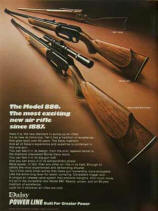 The
1970's - Pneumatics at Last The
1970's - Pneumatics at Last
As far back as the late 1930s, Daisy had been
tracking developments in pneumatic systems for
higher-powered air guns, not because it was
considering a move in that direction, but because it
might offer insights into more efficient systems for
its spring air guns.
In
fact, it wasn’t until 1970 that Daisy decided to
make the move to high-powered adult air guns. Young
adults were demanding more sophisticated equipment
and there were increasing restrictions on area for
shooting firearms. By 1972, Daisy’s first pneumatic
air gun was off the production line and ready to
roll out to the trade.
The
Model 880 pump-up air gun was an immediate success.
To this day, it is still a part of the complete line
of high-powered adult air guns offered by Daisy.
The
1980's - Movies in the Making
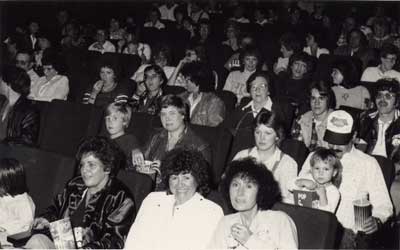
In 1983, the story of young Ralphie Parker hit the
movie screens. Ralphie was a fictional character
from the mind of Jean Shepherd, whose fondest
Christmas dream was of a “…two-hundred shot Red
Ryder range model air rifle with a compass in the
stock and this thing that tells time.”
The
fact that the gun never existed (the gun described
was actually a combination of the Red Ryder and an
earlier gun, the Buck Jones Special) did not deter
the movie production company. In spite of repeated
warnings that “…you’ll shoot your eye out!”, in the
end Ralphie got his gun.
The
movie was an instant box office hit and is now a
cult classic that can be seen each year on
television from the day following Thanksgiving
through Christmas.
The
1990's - Moving into the Future
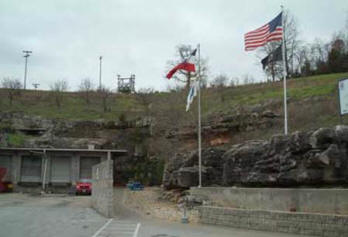 In
the late 1990s, in a continuing effort to control
costs, improve efficiency and ensure quality, the
company began purchasing components from highly
specialized manufacturers. In becoming an assembly
operation, Daisy no longer required the large
manufacturing facility built in Rogers, Arkansas in
1958. In
the late 1990s, in a continuing effort to control
costs, improve efficiency and ensure quality, the
company began purchasing components from highly
specialized manufacturers. In becoming an assembly
operation, Daisy no longer required the large
manufacturing facility built in Rogers, Arkansas in
1958.
In 1995 Daisy acquired Brass Eagle in order to offer
a complete line of paintball markets. (Daisy had
manufactured markers for the forestry and cattle
industries since the 1970s). While Daisy
Manufacturing Company’s corporate headquarters,
customer service operations, some assembly
operations and BB shot manufacturing remained at the
plant at 2111 South 8th Street in Rogers, Brass
Eagle operations were located to an assembly
facility in Granby, Missouri. From April, 1996 until
November, 1997, some Daisy products were also
assembled in the Granby facility while other
production lines remained in Rogers, Arkansas.
When the paintball business became sufficient to
stand alone, the two companies were separated and
stock in Brass Eagle was offered to the public in
November, 1997. However, by April, 1997, Daisy
Manufacturing Company had selected an underground
location in Neosho, Missouri for its assembly
operations. The limestone walls of the underground
facility provided insulation from outside
temperatures. The Neosho facility was headquarters
for not only assembly operations, but for the
purchasing, shipping and receiving, engineering
research and development and quality control staff.
The corporate offices continued to remain in Rogers
as they had since 1958.
The
2000's
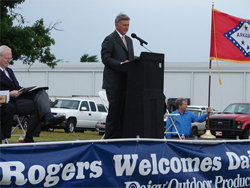 Since
the company had sold the old plant on 8th Street in
July of 1999 and relocated their office to an
industrial park in the north part of Rogers in
November, 1999, the Daisy Museum needed a new home.
We found it in a 1906 bank building at 114 South
First Street. The building had a lot of
architectural character with archways and mosaic
tile floor. It was easy to make our antique airguns
and displays look right at home. The City of Rogers
Parks & Recreation Department had agreed to run the
Daisy Museum on a day to day basis with Daisy’s
support. Several Daisy retirees, devoted to the
Museum’s preservation, founded a non-profit
organization called “Friends of the Museum” which
provided much needed support. In March, 2000,
Arkansas First Lady Janet Huckabee shot a balloon
tied in the middle of a ribbon to officially mark
the opening of the Daisy Airgun Museum. Since
the company had sold the old plant on 8th Street in
July of 1999 and relocated their office to an
industrial park in the north part of Rogers in
November, 1999, the Daisy Museum needed a new home.
We found it in a 1906 bank building at 114 South
First Street. The building had a lot of
architectural character with archways and mosaic
tile floor. It was easy to make our antique airguns
and displays look right at home. The City of Rogers
Parks & Recreation Department had agreed to run the
Daisy Museum on a day to day basis with Daisy’s
support. Several Daisy retirees, devoted to the
Museum’s preservation, founded a non-profit
organization called “Friends of the Museum” which
provided much needed support. In March, 2000,
Arkansas First Lady Janet Huckabee shot a balloon
tied in the middle of a ribbon to officially mark
the opening of the Daisy Airgun Museum.
Daisy’s new product introductions for 2000 included
PowerLine pistols models 400 GX, 45 and 645. TruGlo®
fiber optic front sights were made standard on most
PowerLine rifles and the PowerLline brand of
slingshots were introduced.
Daisy licensed the Winchester brand in 2000 and
introduced a line of Winchester(R) Air Rifles at the
Shooting Hunting and Outdoor Trade (SHOT) Show in
early 2001. The initial lineup included
walnut-stocked, .177 cal. pellet breakbarrel rifles
with maximum velocities of 600, 800 and 1000 fps.
There was also a model 722, a .22 caliber version
which had a maximum velocity of 700 feet per second.
New introductions at the SHOT Show in 2001 also
included the AirStrike model 240 soft air pistol kit
and the PowerLine 622 pellet pistol which featured a
6-shot rotary clip for .22 cal. pellets.
Ray Hobbs was named President, Chief Executive
Officer and Chairman of the Board of Daisy Outdoor
Products in 2001. Ray has brought to Daisy a wealth
of related industry and retail experience as well as
leadership expertise to our management team. His
vision for Daisy continues to contribute to the
company’s consistent growth.
Daisy secured a contract with the U.S. Navy in 2001
to produce nearly indestructible drill rifles which
are being utilized by the U.S. Navy, honor guards,
color guard and drill teams nationwide. At first
glance, the Daisy drill rifle looks like a fully
functional 1903-A3 Springfield rifle with a black
synthetic stock. The design and durable steel
components and synthetic stock make this drill rifle
capable of withstanding the abuse that is inherent
in drill team use.
In 2002, the company introduced the 15XT BB repeater
pistol and ShatterBlast targets, the only breakable
airgun target on the market. In June, 2002, the
company took delivery of a custom-designed Mobile
Airgun Range. The 18 foot steel trailer houses a
5-meter, two shooting point range, complete with
electric target runners.
At the SHOT Show in 2003, the company introduced
several kits, the PowerLine 617X pistol (a six-shot
.177 cal. semi-auto) and The Natural line of
slingshots – the only ergonomically designed
slingshot that allows the wrist to be in the most
natural position when the forks for the slingshot
are perfectly vertical. The Model 1894 was
reintroduced under the Winchester® Air Rifle brand
as a lever action 15-shot BB repeater.
Daisy had relocated the corporate offices from the
old plant on South 8th Street to 400 West Stribling
Drive in Rogers in 1999 but the BB manufacturing
division remained operational in that building until
2003. A tremendous undertaking, the company moved
the BB production equipment to a new location in
Salem, Missouri in March, 2003.
In 2004 the Winchester breakbarrel line was expanded
to include black and synthetic stocks and scoped
models.
January 1, 2004 a non-profit corporation was
founded, The Daisy Airgun Museum. The Daisy Museum
collection was donated to this non-profit and it was
charged with the task of operating the Daisy Museum
with revenues coming from admissions, gift shop and
internet sales and donations from members, the
Friends of the Daisy Museum organization and support
from Daisy Outdoor Products.
On October 25, 2004 the Daisy Museum relocated to
the southwest corner of Second and Walnut streets,
the highest traffic intersection in Historic
Downtown Rogers. The new location is an historic
building, dating to 1896 and known to many residents
as the former Rexall Drug building. The new location
offered the Museum an opportunity to build a maze of
interior walls, further defining periods in Daisy’s
history. The new chronological arrangement of
antique airguns, advertising and memorabilia offers
a more cohesive presentation.
In conjunction with the Museum relocation, the staff
hosted a relocation celebration and open house on
Sunday, November 14th with a ribbon cutting and
silent auction. This date also marked the launch of
a fundraiser to refurbish and relocation of the old
Daisy sign.
On January 31st, 2005, the Daisy Museum, Daisy
Outdoor Products and many of you suffered the loss
of a wonderful friend. David Gates had been a high
school coach in Plymouth, Michigan when the
president of Daisy asked him to write a shooting
education curriculum during the summer school break
in 1955. David did so, and never went back to
coaching at the school. He moved his family from
Michigan to Arkansas in 1958 and held many positions
with Daisy until his retirement. But he was always
involved in education – Daisy’s shooting education
programs and as a member of our community’s school
board. David was instrumental in the efforts to
establish the Daisy Museum in 1999. He was one of
the curators when it opened on First Street in
March, 2000. He truly loved Daisy and the Daisy
Museum and worked hard up until the day that his
health no longer permitted. David was a mentor to
many of us. He was a valuable counsel. It’s not
enough to say that he was a great and true friend.
David was a coach.
In 2006, Daisy celebrated its 120th anniversary. We
are humbled by the fact that we are one of only a
handful of companies that have excelled at making
the same product continuously for 120 years. Our
staff is grateful for the opportunity to continue to
serve in this exciting gratifying and fun industry.
We’re proud to have grown this business, preserved
this great old Daisy brand and defended our position
as the market leader in airguns. Along the way,
we’ve had the pleasure of developing products,
traditions and memories for several generations.
Most Rogers residents and many Rogers visitors
remember the old 1960 neon Daisy sign with lights
which imitated the movement of BBs hitting a target.
In July, 1999, four months before the company moved
its corporate offices from 8th Street in Rogers to
400 Stribling Drive, the old sign had been
dismantled and put in storage by the Rogers Parks
Department. In 2001 the Daisy Museum began a
fund-raising campaign to restore the sign. The sign
was re-erected in front of Daisy headquarters on May
9, 2007 and a dedication ceremony was held on May
14th.
June 20, 2007, Daisy President & C.E.O. Ray Hobbs
and Arkansas Governor Mike Beebe, made an
announcement at a press conference held under a tent
in the field in front of Daisy’s offices: Daisy is
coming home to Rogers. After ten excellent years of
assembly operations in Neosho, Missouri, Daisy would
relocate the entire operations under one roof, in
the same facility in which the company had housed
their offices since November, 1999. The move was
made in record time and on July 25, 2007, the first
Red Ryder came off the production line.
In 2008, Daisy celebrated 50 years in Rogers,
Arkansas. The City of Rogers and Daisy hosted a
four-day weekend celebration which was called a
Homecoming. In addition to Daisy staff, Daisy Museum
personnel, retirees and community friends, 189 Daisy
collectors from every corner of the U.S. and Canada,
registered for the event. An extremely
limited-edition engraved Red Ryder BB gun
commemorated the event and was numbered 1 of 189 in
honor of the 189 people who registered for and
reserved one of the guns.
The ticketed event began with a Rogers-Lowell
Chamber of Commerce Business After Hours reception
under a tent in front of the Daisy offices on
Thursday, June 19th. Tours of the Daisy Museum and
the Daisy assembly operation were offered throughout
the weekend. On Friday afternoon, a picnic was
hosted by Daisy and it was Daisy Night at the
Northwest Arkansas Naturals baseball game. Saturday,
exhibitors displayed and enjoyed a swap meet at the
John Q. Hammons Convention Center, adjacent to the
Embassy Suites host hotel. On-site appraisals were
offered. An activity called “Speed Daisy” allowed
registrants to visit with current Daisy staff and
retirees to hear their personal Daisy stories.
Saturday evening began with a reception and silent
auction, filled with unique one of a kind prototype
Daisy items and other amazing collectibles donated
by those who registered. The group was entertained
by “Melody Lane”, a barbershop quartet who sang
custom lyrics to the tune of “A Bicycle Built for
Two” (a.k.a. “Daisy, Daisy…”). During the banquet,
the program, emceed by Joe Murfin, included a
welcome from Daisy President and C.E.O. Ray Hobbs
and Rogers Mayor Steve Womack.
Establishing the Rogers Daisy Airgun Museum
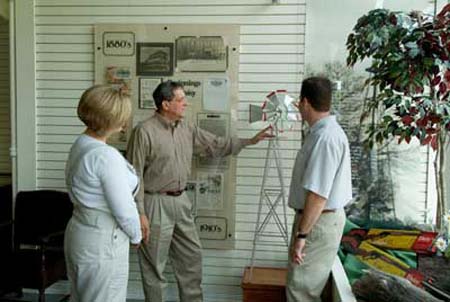 In
January, 1999, when I joined Daisy we were still in
the office building at the old (1958) plant on 8th
street. We had a small room, just off the reception
area, which housed six walnut upright cases, against
the walls. There were two additional walnut
free-standing cases. (These cases were repaired and
moved to the downtown facility when it was built-out).There
was not really any chronological organization to the
presentation of the old Daisy airguns, and there was
no gift shop. It was a self-guided tour of the eight
cases. The plant and offices were on the real estate
market at that time. In
January, 1999, when I joined Daisy we were still in
the office building at the old (1958) plant on 8th
street. We had a small room, just off the reception
area, which housed six walnut upright cases, against
the walls. There were two additional walnut
free-standing cases. (These cases were repaired and
moved to the downtown facility when it was built-out).There
was not really any chronological organization to the
presentation of the old Daisy airguns, and there was
no gift shop. It was a self-guided tour of the eight
cases. The plant and offices were on the real estate
market at that time.
When the plant was sold in July, 1999, the new
owners gave us until Thanksgiving weekend to
re-locate. We found office space in an industrial
park in the north part of town. We realized that the
museum, if it was ever to become a tourist
attraction, would not thrive in the industrial park
setting. We began looking for a new location and
consulted our mayor about our desire to have the
museum become a tourist attraction for the City. Our
mayor is a real Daisy fan (and a Colonel in the Army
Reserves). He was a big help in finding the old 1906
bank building downtown. It was not until our museum
was open that we would discover that that building
once housed the Rogers Historical Museum.
We worked with a local display company to design the
“flow” of the museum, refurbish the old walnut
cases, select items for display and build it out in
time for the opening. The detailed, informative
historic timeline we created was to have appeal to
former employees, local residents and collectors. We
sorted vintage printed material by decade to create
displays that allowed visitors to take a walk
through our history.
Because we had never had personnel dedicated to
giving museum tours, and because a new free-standing
museum would require several people to staff, we
originally spoke to the mayor about asking the
director of our City’s Rogers Historical Museum to
“absorb” the responsibilities of this new downtown
museum and even to house the collection in an annex
of the Historical Museum. Because of stipulations in
current and potential grants, the Historical
Museum’s director wanted to avoid the conflict of
managing a “private collection”.
The Parks and Recreation director, however, was
excited at the opportunity to get involved and
volunteered to establish the Daisy Airgun Museum as
a City of Rogers Park. Frankly, he was the right man
for the right job at the right time – very
resourceful.
We stored the collection from July, 1999, when we
sold the old building, until March, 2000 when we
opened the new museum downtown under a partnership
with the City of Rogers. The City managed the
day-to-day operation of the museum but did not own
the collection. It was a unique but beneficial
partnership.
Being managed by the City allowed us to be
adequately promoted by the state tourism department.
And, we had a Parks Dept. staff which could
cost-efficiently do the type of odd jobs that come
up with you’re running a museum. They built cases,
repaired displays, mopped, moved things, etc. just
like they would at any other Parks facility.
Daisy retirees with an interest in preserving the
collection and supporting the efforts of the museum
created a non-profit corporation. The non-profit was
entitled “Friends of the Daisy Airgun Museum” in
order to be able to solicit donations of cash and
artifacts. Over the course of three years, the
“Friends” collected $4,750 in donations to restore
the old Daisy sign and in excess of $6,000 in
additional unrestricted donations.
Long term, however, it was never our intention nor
was it ever the City’s intention to operate the
Museum jointly. Froom 2000 to 2003, Daisy had
continued to subsidize the museum annually so that
it would not be a burden on the taxpayers.
Therefore, in 2003 we began studying the question of
whether it was better and/or more costly to
subsidize the Museum or just manage it. We created a
business plan for the Museum that included the
creation of a new non-profit corporation.
The exciting thing about the Daisy Museum today is
that it is not owned or operated by Daisy nor is it
owned and operated by the City of Rogers. We have
created a non-profit corporation which owns the
collection, pays for the labor and, in every other
way, is responsible for the day-to-day operation of
the Museum. In this way, donations of money,
antiques as well as the proceeds of Museum sales all
go to the Daisy Airgun Museum, a non-profit entity
with the sole responsibility of managing and
protecting the collection and handling internet and
gift shop sales.
David Gates, John Ford, Orin Ribar (long-time Daisy
associates) and Sue Secker, who were employed by the
City under the former agreement, are now retained by
the non-profit. The bylaws protect the collection in
perpetuity.
Charter members of the board of the non-profit
originally included Joe Murfin as chairman, Ray
Hobbs and Marianne McBeth. In June, 2004, upon the
dissolution of the “Friends of the Daisy Museum”,
the board created two new positions and elected Orin
Ribar and David Gates.
On October 25th, 2004, the Museum was relocated to
the southwest corner of Second and Walnut Streets.
The new location is an historic building, dating to
1896 and known to many residents as the former
Rexall Drug building. The location was selected for
the high traffic count for tourists visiting
historic downtown Rogers and passing through town on
their way to Beaver Lake, Eureka Springs and
Branson.
The new location offered the Museum an opportunity
to build a maze of interior walls, further defining
periods in Daisy’s history. The new chronological
presentation of antique airguns, advertising and
memorabilia offers a more cohesive presentation.
In conjunction with the Museum relocation, the staff
hosted a relocation celebration and open house on
Sunday, November 14th with a ribbon cutting and
silent auction. This date also marked the launch of
a fundraiser to refurbish and relocation of the old
Daisy sign. Various levels of donor awards were made
available and response from Daisy retirees, business
associates, community leaders and the general public
was generous. The Daisy sign is to be strategically
placed in front of Daisy corporate offices, but more
importantly strategically placed to lead visitors to
the Daisy Museum. The reverse side will thank
visitors for visiting historic downtown Rogers.
On January 31st, 2005, the Daisy Museum, Daisy
Outdoor Products and many of you suffered the loss
of a wonderful friend. David Gates had been a high
school coach in Plymouth, Michigan when the
president of Daisy asked him to write a shooting
education curriculum during the summer school break
in 1955. David did so, and never went back to
coaching at the school. He moved his family from
Michigan to Arkansas in 1958 and held many positions
with Daisy until his retirement. But he was always
involved in education – Daisy’s shooting education
and as a member of our community’s school board.
David was instrumental in the efforts to establish
the Daisy Museum in 1999. He was one of the curators
when it opened on First Street in March, 2000. He
worked hard up until the day that his health no
longer permitted. David was a mentor to many of us.
He was a valuable counsel. He was a great and true
friend. David was a coach.
Few
people, today, dedicate their entire career (and
beyond) to one company. Orin Ribar did. Orin's
mother, Annabelle, was working in the service
department at Daisy in Plymouth, Michigan, when Orin
graduated high school. Orin went to work in the
service department on June 23, 1953. It was there
that he met Patt Wohn. They married in 1955, and,
with their two young daughters, joined other Daisy
families who relocated to Rogers, Arkansas, in 1958.
When Orin passed on to larger life on July 19, 2021,
he was the last remaining Daisy retiree who had made
the move from Plymouth to Rogers, Arkansas. Orin and
the late Patt Ribar's daughters, Sherri Ribar and
Lisa Pierce, each worked in the Daisy plant. Their
son, Steven Ribar, worked in the plant and now
serves as Art Director for Daisy. Steven is also a
member of he Daisy Museum board of directors. Orin
retired from Daisy in 1996. He served the Daisy
Museum as Curator. A comprehensive tour of the
museum by Orin became the script for the museum's
audio tour. Orin was a walking encyclopedia of Daisy
history, facts, products and folklore. During his
years at the Daisy Museum, Orin would often see a
gap in the museum's collection and bring a gun from
his personal collection in order to better tell the
company's story. In a generous gesture, Orin donated
these artifacts to the non-profit Daisy Museum. As a
testament to his generous willingness to share, and
to the importance of his family, many display areas
in the museum today bear tags that read, "Donated by
the Orin Ribar Family."
|